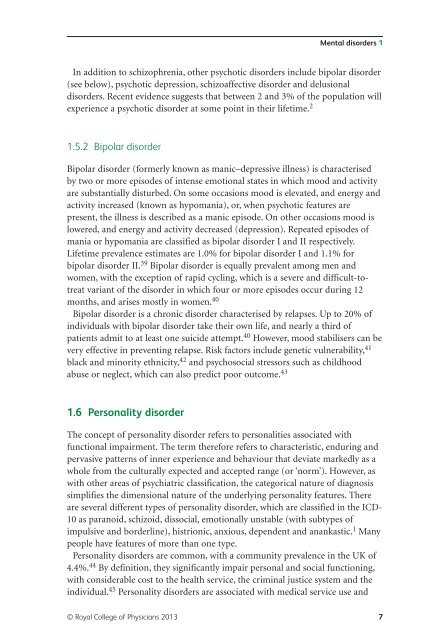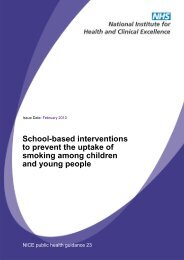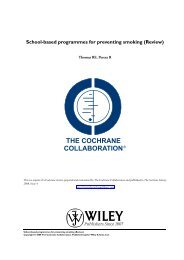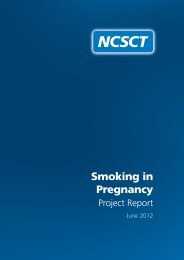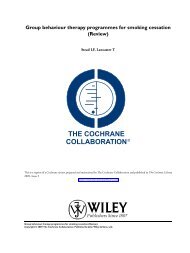Smoking and mental health - NCSCT
Smoking and mental health - NCSCT
Smoking and mental health - NCSCT
Create successful ePaper yourself
Turn your PDF publications into a flip-book with our unique Google optimized e-Paper software.
Mental disorders 1<br />
In addition to schizophrenia, other psychotic disorders include bipolar disorder<br />
(see below), psychotic depression, schizoaffective disorder <strong>and</strong> delusional<br />
disorders. Recent evidence suggests that between 2 <strong>and</strong> 3% of the population will<br />
experience a psychotic disorder at some point in their lifetime. 2<br />
1.5.2 Bipolar disorder<br />
Bipolar disorder (formerly known as manic–depressive illness) is characterised<br />
by two or more episodes of intense emotional states in which mood <strong>and</strong> activity<br />
are substantially disturbed. On some occasions mood is elevated, <strong>and</strong> energy <strong>and</strong><br />
activity increased (known as hypomania), or, when psychotic features are<br />
present, the illness is described as a manic episode. On other occasions mood is<br />
lowered, <strong>and</strong> energy <strong>and</strong> activity decreased (depression). Repeated episodes of<br />
mania or hypomania are classified as bipolar disorder I <strong>and</strong> II respectively.<br />
Lifetime prevalence estimates are 1.0% for bipolar disorder I <strong>and</strong> 1.1% for<br />
bipolar disorder II. 39 Bipolar disorder is equally prevalent among men <strong>and</strong><br />
women, with the exception of rapid cycling, which is a severe <strong>and</strong> difficult-totreat<br />
variant of the disorder in which four or more episodes occur during 12<br />
months, <strong>and</strong> arises mostly in women. 40<br />
Bipolar disorder is a chronic disorder characterised by relapses. Up to 20% of<br />
individuals with bipolar disorder take their own life, <strong>and</strong> nearly a third of<br />
patients admit to at least one suicide attempt. 40 However, mood stabilisers can be<br />
very effective in preventing relapse. Risk factors include genetic vulnerability, 41<br />
black <strong>and</strong> minority ethnicity, 42 <strong>and</strong> psychosocial stressors such as childhood<br />
abuse or neglect, which can also predict poor outcome. 43<br />
1.6 Personality disorder<br />
The concept of personality disorder refers to personalities associated with<br />
functional impairment. The term therefore refers to characteristic, enduring <strong>and</strong><br />
pervasive patterns of inner experience <strong>and</strong> behaviour that deviate markedly as a<br />
whole from the culturally expected <strong>and</strong> accepted range (or ‘norm’). However, as<br />
with other areas of psychiatric classification, the categorical nature of diagnosis<br />
simplifies the dimensional nature of the underlying personality features. There<br />
are several different types of personality disorder, which are classified in the ICD-<br />
10 as paranoid, schizoid, dissocial, emotionally unstable (with subtypes of<br />
impulsive <strong>and</strong> borderline), histrionic, anxious, dependent <strong>and</strong> anankastic. 1 Many<br />
people have features of more than one type.<br />
Personality disorders are common, with a community prevalence in the UK of<br />
4.4%. 44 By definition, they significantly impair personal <strong>and</strong> social functioning,<br />
with considerable cost to the <strong>health</strong> service, the criminal justice system <strong>and</strong> the<br />
individual. 45 Personality disorders are associated with medical service use <strong>and</strong><br />
© Royal College of Physicians 2013 7


